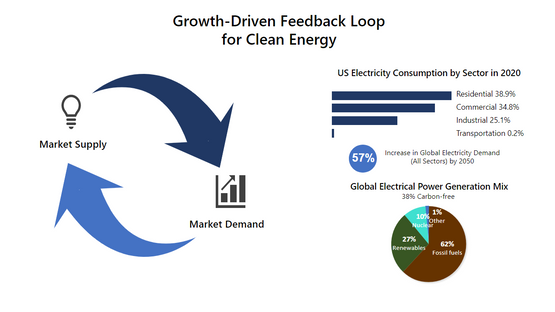The Case for Carbon-Free Electricity
Our Carbon-free future needs to begin and end with ubiquitous and equitable availability of electricity. Even though green, or green’ish, technologies increasingly factor into the production and distribution of electricity, just over one-quarter of all Carbon-based emissions originate from this ‘essential service’.
Our appetite for electricity is amplified downstream in other areas that contribute to anthropogenic emissions. From manufacturing and construction to transportation, agriculture to HVAC (heating, ventilation, and air conditioning), the drivers for downstream consumption of electricity originate here. Thus, through its use, electricity production and distribution are also indirectly implicated for their emissions contributions. Because the supply-demand dynamics of its production, distribution, and use remain relevant in any vision of a decarbonized future, the significance of reimagining electricity is pivotal in any attempt to ‘go green’. For example, green electric vehicles (EVs) still need to make use of electricity – electricity produced upstream and distributed to charging stations.
According to The World Bank for 10% of our global population, electricity is not an essential service today – at best it is available intermittently, and at worst, not all. Thus, the impetus for greening electricity production and distribution must account for deployment and use in unstable, developing regions, or areas experiencing energy poverty. As these regions establish and amplify their electricity requirements, the use of Carbon-based options needs to be averted – even though this traditional option may be readily available and perceived as inexpensive, and effective, in the short term.
Only for brevity here, will we lump in our need to heat and cool those places where we live, work, play, and otherwise visit. When we do, the emissions-burden of electricity escalates to about one-third. Directly then, electricity accounts for some 34% of the 51 billion tons of greenhouse-active gases we contribute to the atmosphere annually.
The Reality of Renewables
Without question, electricity is in dire need of a green disruption. It would be truly wonderful if we could tap solar and wind power to make up the shortfall of sunsetting existing Carbon-based generation. Whereas these renewable energy sources have successfully transitioned from R&D prototypes into production-grade deployments, they have also served to underscore our ‘inconvenient relationship’ with fossil fuels on several fronts. Most importantly, solar and wind generation would need to be scaled to astronomical proportions (literally) to compete with the innate energy density (e.g., power generated per square meter) inherent in fossil fuels. Unfortunately, this picture is not altered in any significant way when hydropower is added into the generation mix.
It is important to note that the energy-density realities of renewables relative to Carbon-based approaches are in no way intended to disparage potential energy sources such as insolation (incoming solar radiation) or flowing fluids (e.g., wind or water). Rather, strategies for decarbonized electricity generation are better informed. First, renewable, or otherwise, higher-density energy sources are needed. Second, even with such sources, there is likely to remain an ongoing need to aggregate power from multiple sources.
At the present time, there are two candidates whose prospects appear particularly promising.
Rebooting Nuclear Energy
The first prospect is familiar in name: nuclear energy. Importantly, as a means for generating electricity, nuclear energy already achieves an energy density that is within the same ballpark (e.g., a factor of 10 at the dense end of the spectrum) of that achievable with fossil fuels. In comparison, renewables are off by factors of 25 (solar power today) to 250 (wind power) even in best-case scenarios. Of course, the energy density of any challenger does not need to beat or even match what can be achieved with fossil fuels today; challengers need only be practical when scaled up – i.e., not require astronomical proportions.
Even though it is contributing to electrical power generation on a routine and consistent basis across the planet, nuclear energy has an ‘image problem’. Hence, there exists the potential for significant sensitivity regarding any mention of increasing the mix of nuclear energy in the electricity-generation portfolio. Of the four areas of concern that have been identified, safety tops the list.
In addition to safety, the current renaissance of nuclear energy seeks to address concerns relating to cost, the potential for proliferation (i.e., to weapons-grade enrichment levels), and even waste. When it comes to waste, some reactor designs are particularly innovative as they can make use of spent fuel (i.e. waste) from conventional generation plants. Splitting atoms (i.e. nuclear fission) has proven itself to be a viable approach for generating electricity. Given that it is also dense in the energy-generating sense, next-generation nuclear technologies emerge as viable prospect for decarbonizing the generation of electricity. Next-gen nuclear is already a focal point for innovation, with some offerings ready to emerge from the R&D lab for proof-of-concept deployment.
Energy from Hydrogen
Other than renewables, it is only Hydrogen that might be perceived as a ‘silver bullet’ for decarbonizing electricity. First, it is readily available … in different colors, no less!
Table 1 The different colors of Hydrogen. For each color, the extraction process is identified along with the source of the gas. Brown, gray, and blue, depend upon a fossil-fuel source. Turquoise Hydrogen can be produced from any source of methane – i.e., from fossil fuels or some alternative (e.g., a landfill site). Green Hydrogen has no dependency on fossil fuels.
Through cooling and pressurization, Hydrogen can be liquified and stored for later consumption – regardless of its original color. To extract energy from Hydrogen, the fuel is combined with air in a fuel cell. Green Hydrogen is the only member of the palette that has the potential to be completely decarbonized. Although the details of the reactions involved in an electrochemical cell are more involved, the essence is that water vapor is the ultimate product – again, regardless of the color of Hydrogen that is used. Other than a change of state, green Hydrogen is renewable-energy source to a degree.
Microsoft demonstrated that they could power a row of datacenter servers for 48 consecutive hours through use of Hydrogen-based fuel cells. This demonstration proved to be both a tactical and strategic win, as the Hydrogen-based solution stood in for, and could ultimately replace, a traditional solution based on use of a diesel generator.
There is no question that green Hydrogen has the potential to be extremely interesting in serious net-zero conversations. Hydrogen is literally the most-abundant element in the Universe. However, as appealing as all of this sounds, our enthusiasm may need to be tempered somewhat. Green Hydrogen, for example, requires a lot of pure water to produce the fuel-grade gas. Given that some parts of the planet have existing concerns with water and its use, development of a Hydrogen economy may need to proceed with caution. Finally, storage of Hydrogen has proven challenging in the past; while not insurmountable, scaling use of Hydrogen will require ongoing innovation.
Summing Up
The direct anthropogenic impact of the production, distribution, and use, of electricity is sizeable. Because downstream sources of emissions establish an escalating demand, amplified in areas where the need is greatest, the impact of equitable power generation is magnified. Whereas renewables will offer some relief, a net-zero solution demands more-capable options if we are to eliminate our reliance upon fossil fuels. Although innovation remains a requirement, power generation via some mix of next-generation nuclear and Hydrogen-based technologies appears to be the most promising at the current time.
Microsoft sustainability guide
Posted at https://sl.advdat.com/34XJbh6

